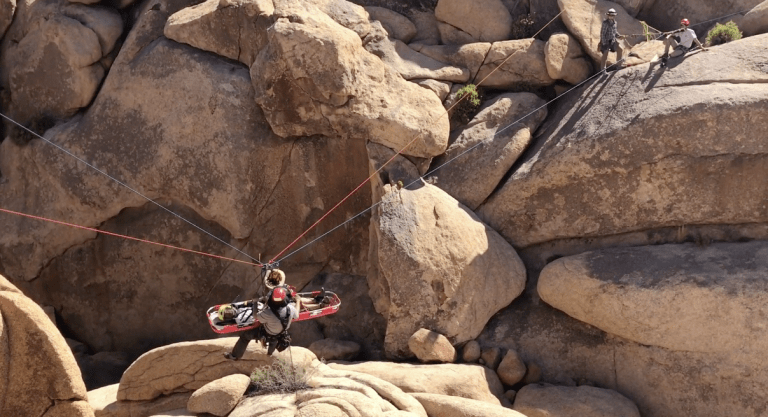Almost all rope rescue systems used could be considered a “two rope system”. Traditional mainline / slack belay systems and twin tension rope systems (TTRS) both use two (2) ropes. However, the similarities stop there. I won’t get into the biopsy of the mainline-belay line system because, well… they have been around forever. The “relatively” new TTRS is where things need to move to.
In a TTRS both the main and belay(usually now termed as primary and secondary) are under tension via separate controlled descent devices. As both lines are equally likely to fail the controlled descent device must be backed up with a belay device (usually placed behind the CD device) or a device such as a MPD that performs both functions must be employed. Since both lines are under load the only rope stretch that will be seen in a line failure is the difference between the single person to two – person rope stretch. This is usually around 3% in static ropes. For instance, if you had 300’ of rope in service and broke a line, the rescue load could fall 9’ before weighting the other line. This also means that you have reduced your time off belay to a third of a DM/DB system.
Two Rope Systems have a few other terms… Offsets, Cross Hauling, Pendulums to name a few. In all of these systems, both “ends” are working together to move and or position the “package” into place. You may have heard of a “drooping highline”? Well, these are really highlines and I am calling this into references as an oxymoron. A highline is a highline and an offset is an offset. The primary advantage, with offsets, is the lower vector forces. We get into this and many other aspects (and comparisons) in our Rigging Physics Courses… Particularly Part 1.
Spanning big gaps are the primary use for a two rope offset or cross haul system.
If a picture is worth a thousand words, then a video is worth millions and two videos…? Well, a lot more.
This is the classic “cross haul” seen in the rope access industry. Run primarily by two persons, the job or goal is to haul the “casualty” across a space or gap. Typically used in the industrial settings, this system is pretty much identical to that of what is seen and used in rope rescue environment.
So here we’ve got a “standard” two rope offset system. Using a twin MPD set up (on both sides), the system ready for a raise and or lower at a moments notice. Note… this same system serves classic horizontal to verticle (high angle to steep angle) evolutions. The “shared load” is so much easier on the vector forces and system technicians.
A “twin tension” working offset or cross haul system gives technicians tools to solve almost just about 90% (or more) of the problems out there. These systems are relatively fast to set up and much cleaner. I hope the point I am hoping to drive home is the cross-pollination happening within the rope rescue and rope access industries. The same is true with the working at height cousins… the arbor and the rope access industries. I will be building more of these side by side comparison in future blogs.
There is always the critical point failure, but with devices such as the Petzl I’d or the CMC MPD… the critical point failure argument is pretty mute.
Peace on your Days…
Lance
[thrive_leads id=’51985′]










10 thoughts on “Two Rope System Cross Pollination: A Tale of Two Industries”
Greetings! Very helpful advice on this article! It is the little changes that make the biggest changes. Thanks a lot for sharing!
This is a topic close to my heart cheers, where are your contact details though?
I wanted to thank you for this great read!! I definitely enjoying every little bit of it I have you bookmarked to check out new stuff you post…
984635 211307An intriguing discussion is worth comment. Im confident that you merely write regarding this topic, may possibly not be considered a taboo topic but typically persons are too small to communicate on such topics. To yet another. Cheers 768708
377504 559945Merely wanna input that you have a really good web web site , I really like the pattern it actually stands out. 755292
Your place is valueble for me. Thanks!…
711256 656929hi there, your website is discount. Me thank you for do the job 473658
605506 773815There will likely be several entirely different portions about the LA Weight reduction eating plan and 1 is really important. Begin stage is your really truly of these extra load. weight loss 434275
513845 484270Hi, you used to write superb articles, but the last several posts have been kinda boring I miss your tremendous posts. Past few posts are just a bit out of track! 803739
I was suggested this web site by my cousin. I’m not sure whether this post is written by him as nobody else know such detailed about my problem. You are wonderful! Thanks!
Comments are closed.